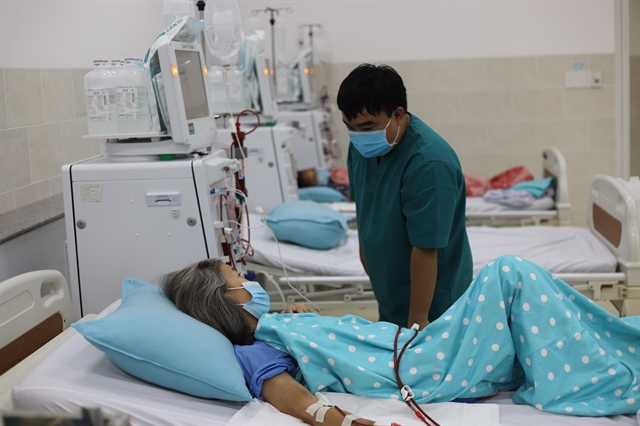 Society
Society

 |
| A patient undergoes kidney dialysis at Hồng Hưng Hospital. VNA/VNS Photo Lê Đức Hoảnh |
HÀ NỘI – Dialysis treatment for people with chronic kidney disease can be tough at the best of times.
But when you live hundreds of kilometres from the hospital providing that care, it makes pain relief all that more painful.
Nguyễn Thị Huệ experiences this every time she needs dialysis.
The 41-year-old lives in Yên Bái Province, around 300km from Hà Nội where she needs regular treatment.
Often she has to stay in the capital for many days to receive care. Away from her family and far from home.
The financial implications of her travel and accommodation expenses add to the already heavy weight on her shoulders.
“I receive kidney treatment at Bạch Mai Hospital, so I have to travel to Hà Nội every month,” Huệ said.
“Sometimes, I need to rent a place to stay longer for dialysis. My children are still small and our finances are limited so my family has faced significant hardships since my illness began.”
Việt Nam currently has more than 10 million people suffering from chronic kidney disease, accounting for 10.1 per cent of the population.
This disease ranks eighth among the top 10 causes of death in Việt Nam, with more than 8,000 new cases diagnosed each year.
The challenge of kidney treatment
The treatment approach for chronic kidney disease varies depending on the stage of the patient’s condition. Patients in the late stages often require dialysis or even transplants.
Associate Professor Dr Nguyễn Thị Xuyên, President of the Vietnam Medical Association, said: “Currently, in Việt Nam, we have only 5,500 dialysis machines used for 33,000 patients, while there are more than 800,000 patients require dialysis.”
Her data also shows that half of the patients receiving dialysis treatment die within five years while being charged medical costs three times higher than those who received treatment in the early stages.
Xuyên said: “The treatment burden for chronic kidney disease patients is rapidly increasing and is predicted to become the fifth leading cause of years of life lost worldwide by 2040.
“This burden is increasing faster in low and middle-income countries, including Việt Nam.”
Associate Professor Dr. Nguyễn Khoa Diệu Vân, Vice President of the Vietnam Endocrinology and Diabetes Association, emphasised that impaired kidney function significantly increases the risk of cardiovascular complications and deaths while reducing the quality of life.
Vân said: “Around 1.2 million people die from chronic kidney disease each year, in addition to 1.4 million people who die from heart disease due to impaired kidney function and over 2 million people who die due to a lack of access to dialysis.”
Chronic kidney disease is silently increasing globally, with more than 840 million cases worldwide, accounting for 11 to 13.4 per cent of the population. Of these, two-thirds of the cases are in low and middle-income countries.
Early diagnosis is crucial
There are no clear symptoms in the early stages of chronic kidney disease and most of the patients receive their diagnosis in the later stages.
Vân said: “Almost no patient mentions kidney disease when they go for check-ups and health examinations. This explains why only 4.5 to 15.5 per cent of adults with chronic kidney disease are diagnosed. Typically, when it is discovered, patients have already reached stages three or four.
“Only 5 per cent of adults are diagnosed with the disease at stage 3 while most cases are discovered when they are already at stages four or five requiring kidney replacement.
“It is estimated that by 2030, there will be 5 million people in need of kidney replacement. Therefore, early diagnosis and intervention in chronic kidney disease distributes great significance to patients.”
Studies on the group of SGLT-2i inhibitors, especially Dapagliflozin, have shown positive results in managing chronic kidney disease. However, this is the best approach to managing chronic kidney disease from its early stages.
It has shown a 39 per cent reduction in the risk of disease progression and a 31 per cent reduction in mortality risk of patients with chronic kidney disease.
Xuyên added: “The Ministry of Health has recently encouraged the implementation and development of clinical research, alongside the establishment of national treatment guidelines based on research results to enhance the effectiveness and quality of patient care.
“In addition, we should enhance the early diagnosis of chronic kidney disease through high-sensitivity diagnostic tests.
“This solution should be implemented at the grassroots healthcare level to enable earlier detection and intervention.”
Việt Nam has become an important research hub and actively participated in global clinical development programmes in various fields, particularly in the areas of cardiovascular-kidney-metabolic diseases, especially chronic kidney disease. – VNS




